Analyzing IMO's Strategies for Climate Change in the Shipping Industry
VerifiedAdded on 2023/05/28
|6
|1498
|500
Report
AI Summary
This report examines the International Maritime Organization's (IMO) strategic plan to address climate change within the shipping industry, focusing on the period between 2018 and 2023. The IMO aims to promote sustainable development by managing resources and implementing regulations to reduce pollution and global warming. Key strategies include collecting fuel consumption data for policy formulation, aligning with the Paris Agreement goals, and implementing short, medium, and long-term emission reduction targets. The IMO's initiatives, such as MARPOL 73/78 and its annexes, aim to prevent marine pollution from shipping activities. Challenges include criticisms from NGOs regarding the adequacy of measures and opposition from certain nations. The report emphasizes the need for effective implementation of regulations, increased investment in emission reduction technologies, and international cooperation to achieve a decarbonized shipping sector and mitigate the negative impacts of climate change on the environment and wildlife. The IMO is also exploring carbon pricing technologies to further improve emission control and seeks support from shipping agencies, fuel suppliers, and governments to achieve its goals.
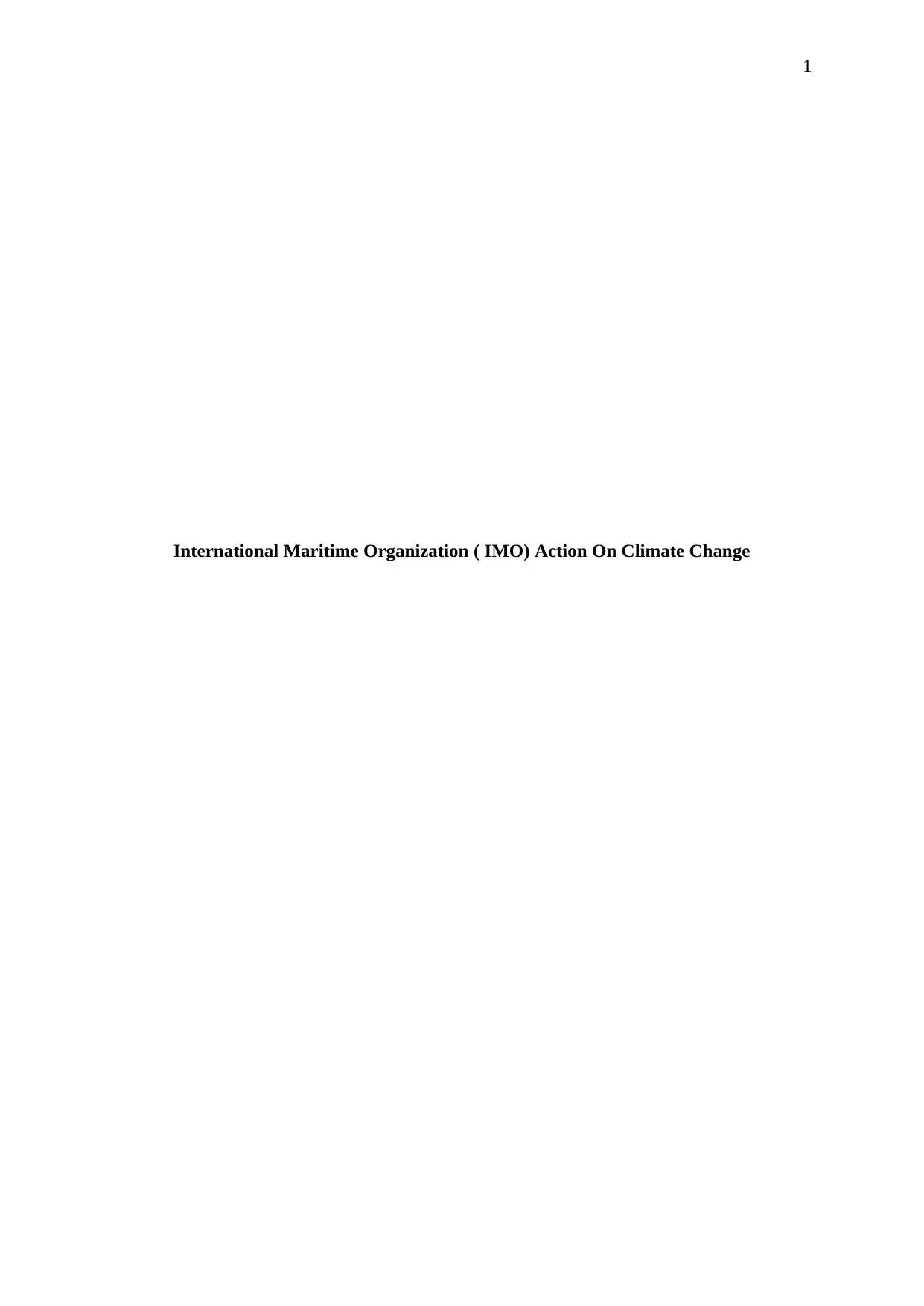
1
International Maritime Organization ( IMO) Action On Climate Change
International Maritime Organization ( IMO) Action On Climate Change
Paraphrase This Document
Need a fresh take? Get an instant paraphrase of this document with our AI Paraphraser
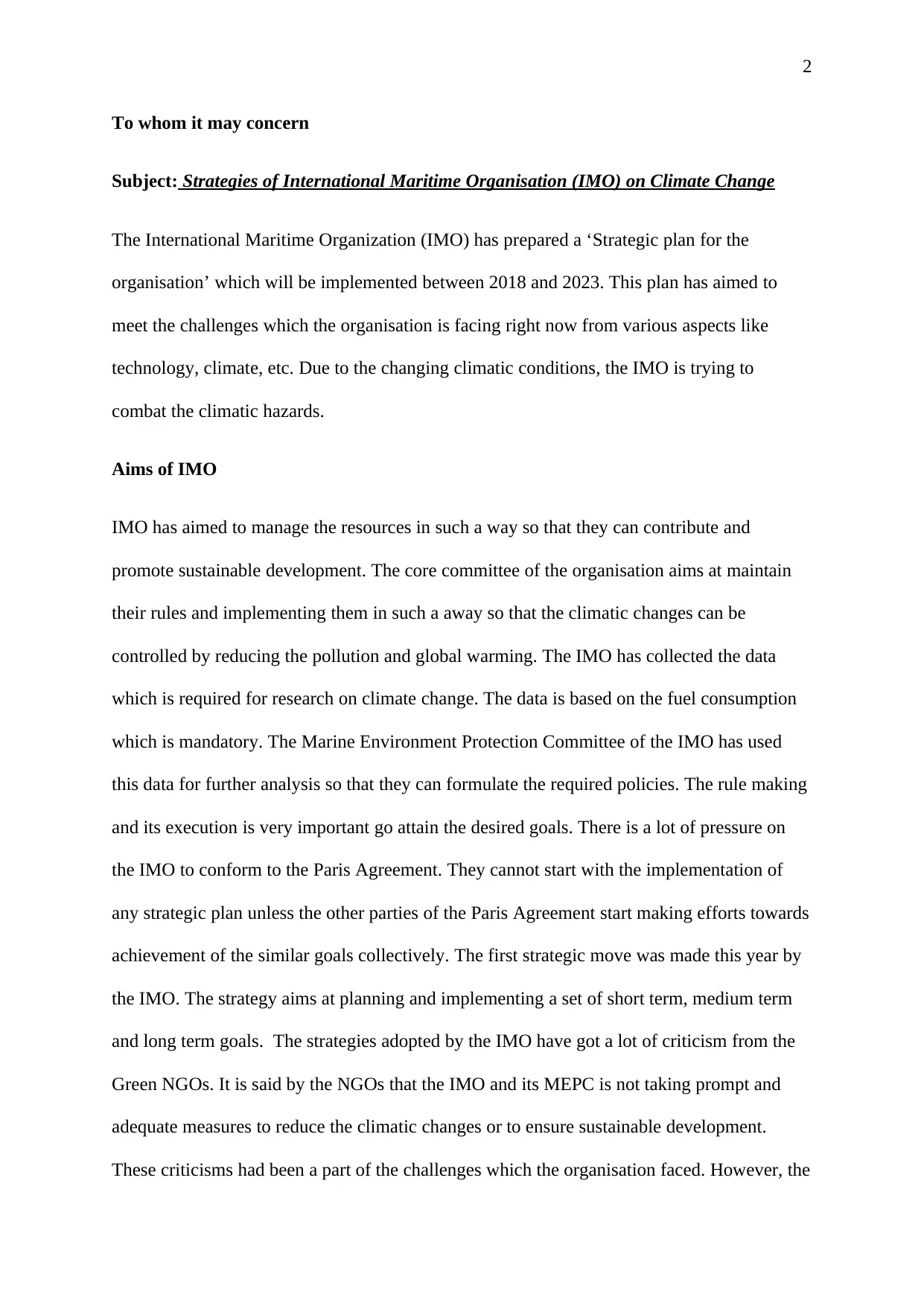
2
To whom it may concern
Subject: Strategies of International Maritime Organisation (IMO) on Climate Change
The International Maritime Organization (IMO) has prepared a ‘Strategic plan for the
organisation’ which will be implemented between 2018 and 2023. This plan has aimed to
meet the challenges which the organisation is facing right now from various aspects like
technology, climate, etc. Due to the changing climatic conditions, the IMO is trying to
combat the climatic hazards.
Aims of IMO
IMO has aimed to manage the resources in such a way so that they can contribute and
promote sustainable development. The core committee of the organisation aims at maintain
their rules and implementing them in such a away so that the climatic changes can be
controlled by reducing the pollution and global warming. The IMO has collected the data
which is required for research on climate change. The data is based on the fuel consumption
which is mandatory. The Marine Environment Protection Committee of the IMO has used
this data for further analysis so that they can formulate the required policies. The rule making
and its execution is very important go attain the desired goals. There is a lot of pressure on
the IMO to conform to the Paris Agreement. They cannot start with the implementation of
any strategic plan unless the other parties of the Paris Agreement start making efforts towards
achievement of the similar goals collectively. The first strategic move was made this year by
the IMO. The strategy aims at planning and implementing a set of short term, medium term
and long term goals. The strategies adopted by the IMO have got a lot of criticism from the
Green NGOs. It is said by the NGOs that the IMO and its MEPC is not taking prompt and
adequate measures to reduce the climatic changes or to ensure sustainable development.
These criticisms had been a part of the challenges which the organisation faced. However, the
To whom it may concern
Subject: Strategies of International Maritime Organisation (IMO) on Climate Change
The International Maritime Organization (IMO) has prepared a ‘Strategic plan for the
organisation’ which will be implemented between 2018 and 2023. This plan has aimed to
meet the challenges which the organisation is facing right now from various aspects like
technology, climate, etc. Due to the changing climatic conditions, the IMO is trying to
combat the climatic hazards.
Aims of IMO
IMO has aimed to manage the resources in such a way so that they can contribute and
promote sustainable development. The core committee of the organisation aims at maintain
their rules and implementing them in such a away so that the climatic changes can be
controlled by reducing the pollution and global warming. The IMO has collected the data
which is required for research on climate change. The data is based on the fuel consumption
which is mandatory. The Marine Environment Protection Committee of the IMO has used
this data for further analysis so that they can formulate the required policies. The rule making
and its execution is very important go attain the desired goals. There is a lot of pressure on
the IMO to conform to the Paris Agreement. They cannot start with the implementation of
any strategic plan unless the other parties of the Paris Agreement start making efforts towards
achievement of the similar goals collectively. The first strategic move was made this year by
the IMO. The strategy aims at planning and implementing a set of short term, medium term
and long term goals. The strategies adopted by the IMO have got a lot of criticism from the
Green NGOs. It is said by the NGOs that the IMO and its MEPC is not taking prompt and
adequate measures to reduce the climatic changes or to ensure sustainable development.
These criticisms had been a part of the challenges which the organisation faced. However, the
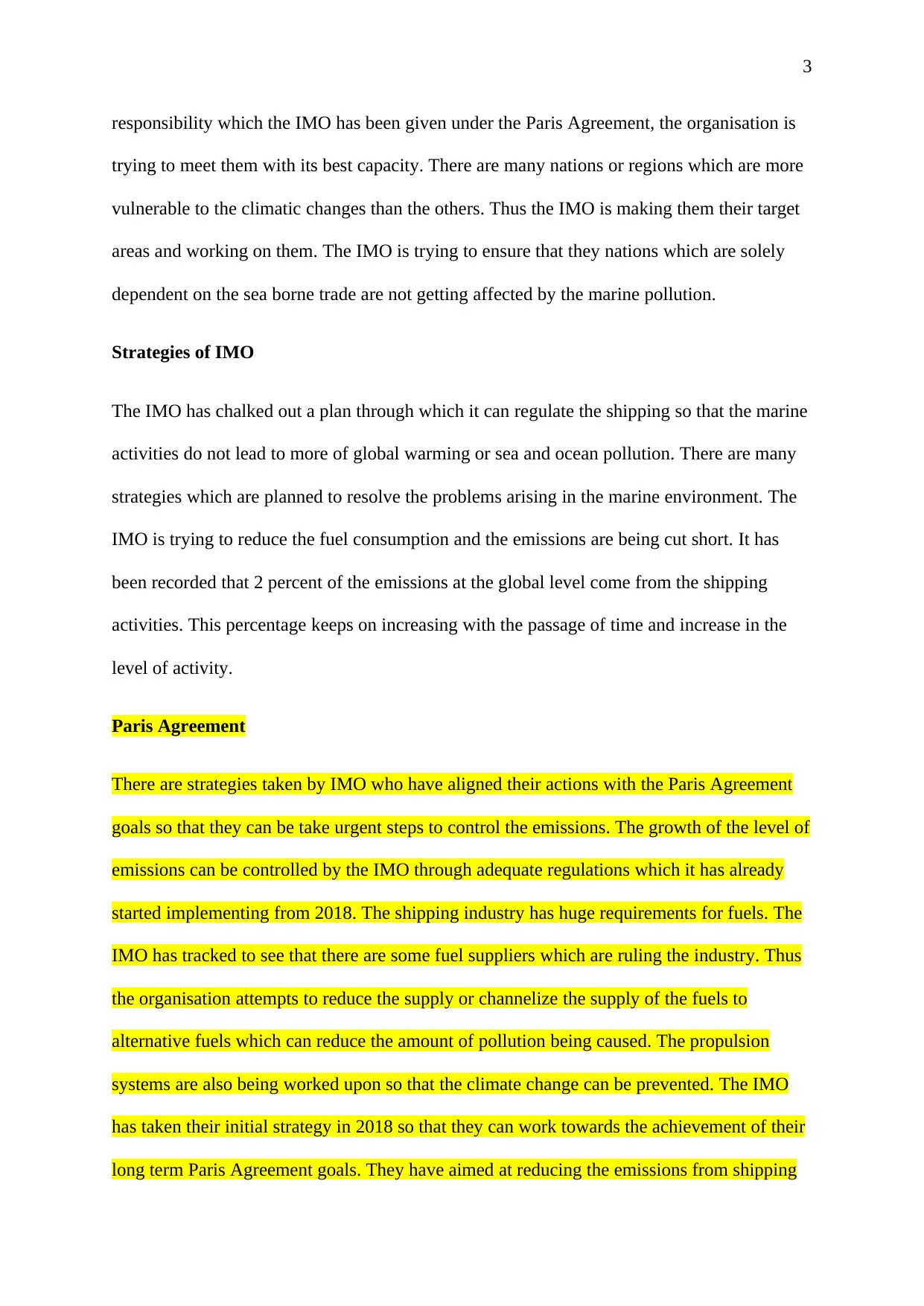
3
responsibility which the IMO has been given under the Paris Agreement, the organisation is
trying to meet them with its best capacity. There are many nations or regions which are more
vulnerable to the climatic changes than the others. Thus the IMO is making them their target
areas and working on them. The IMO is trying to ensure that they nations which are solely
dependent on the sea borne trade are not getting affected by the marine pollution.
Strategies of IMO
The IMO has chalked out a plan through which it can regulate the shipping so that the marine
activities do not lead to more of global warming or sea and ocean pollution. There are many
strategies which are planned to resolve the problems arising in the marine environment. The
IMO is trying to reduce the fuel consumption and the emissions are being cut short. It has
been recorded that 2 percent of the emissions at the global level come from the shipping
activities. This percentage keeps on increasing with the passage of time and increase in the
level of activity.
Paris Agreement
There are strategies taken by IMO who have aligned their actions with the Paris Agreement
goals so that they can be take urgent steps to control the emissions. The growth of the level of
emissions can be controlled by the IMO through adequate regulations which it has already
started implementing from 2018. The shipping industry has huge requirements for fuels. The
IMO has tracked to see that there are some fuel suppliers which are ruling the industry. Thus
the organisation attempts to reduce the supply or channelize the supply of the fuels to
alternative fuels which can reduce the amount of pollution being caused. The propulsion
systems are also being worked upon so that the climate change can be prevented. The IMO
has taken their initial strategy in 2018 so that they can work towards the achievement of their
long term Paris Agreement goals. They have aimed at reducing the emissions from shipping
responsibility which the IMO has been given under the Paris Agreement, the organisation is
trying to meet them with its best capacity. There are many nations or regions which are more
vulnerable to the climatic changes than the others. Thus the IMO is making them their target
areas and working on them. The IMO is trying to ensure that they nations which are solely
dependent on the sea borne trade are not getting affected by the marine pollution.
Strategies of IMO
The IMO has chalked out a plan through which it can regulate the shipping so that the marine
activities do not lead to more of global warming or sea and ocean pollution. There are many
strategies which are planned to resolve the problems arising in the marine environment. The
IMO is trying to reduce the fuel consumption and the emissions are being cut short. It has
been recorded that 2 percent of the emissions at the global level come from the shipping
activities. This percentage keeps on increasing with the passage of time and increase in the
level of activity.
Paris Agreement
There are strategies taken by IMO who have aligned their actions with the Paris Agreement
goals so that they can be take urgent steps to control the emissions. The growth of the level of
emissions can be controlled by the IMO through adequate regulations which it has already
started implementing from 2018. The shipping industry has huge requirements for fuels. The
IMO has tracked to see that there are some fuel suppliers which are ruling the industry. Thus
the organisation attempts to reduce the supply or channelize the supply of the fuels to
alternative fuels which can reduce the amount of pollution being caused. The propulsion
systems are also being worked upon so that the climate change can be prevented. The IMO
has taken their initial strategy in 2018 so that they can work towards the achievement of their
long term Paris Agreement goals. They have aimed at reducing the emissions from shipping
⊘ This is a preview!⊘
Do you want full access?
Subscribe today to unlock all pages.

Trusted by 1+ million students worldwide
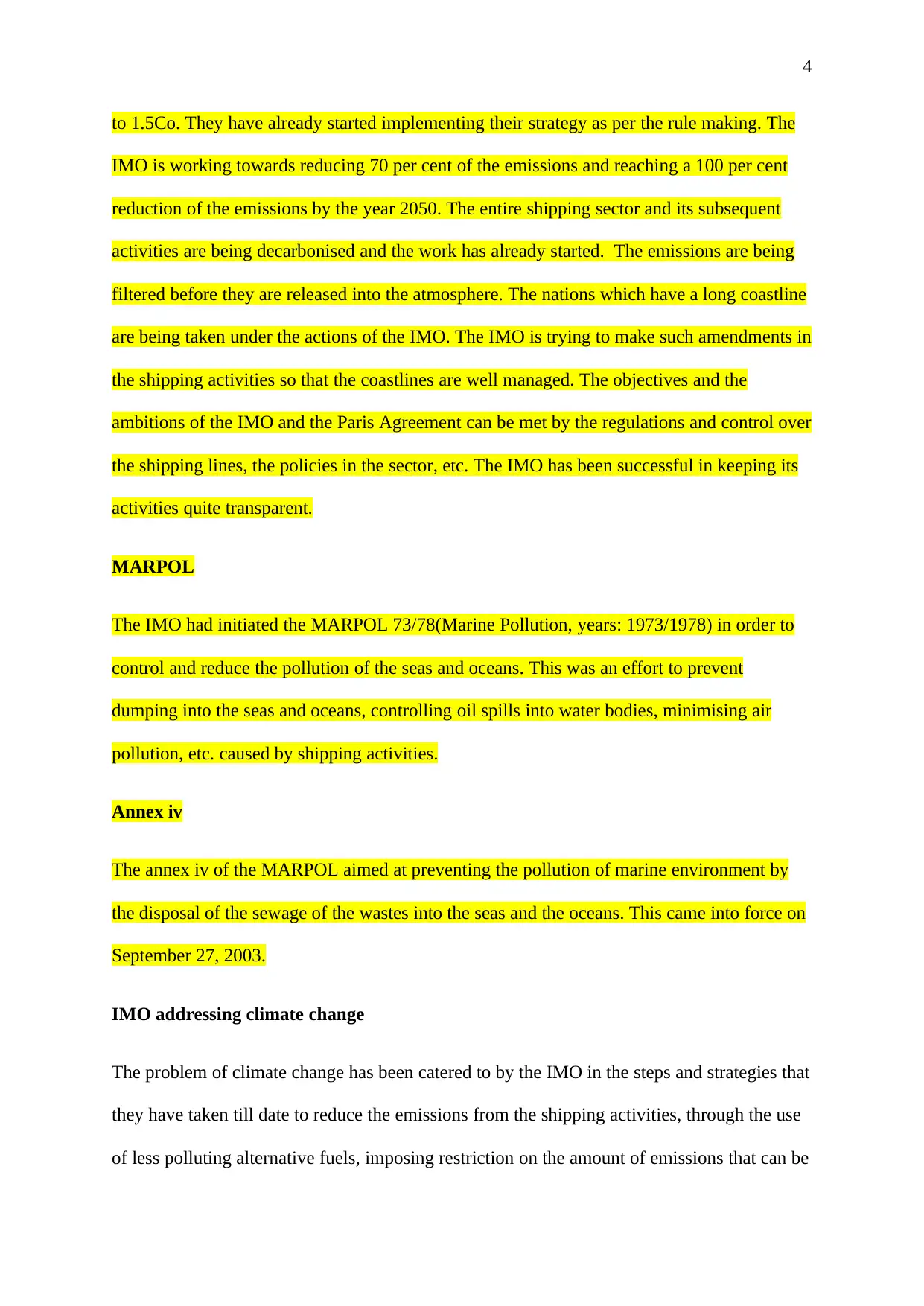
4
to 1.5Co. They have already started implementing their strategy as per the rule making. The
IMO is working towards reducing 70 per cent of the emissions and reaching a 100 per cent
reduction of the emissions by the year 2050. The entire shipping sector and its subsequent
activities are being decarbonised and the work has already started. The emissions are being
filtered before they are released into the atmosphere. The nations which have a long coastline
are being taken under the actions of the IMO. The IMO is trying to make such amendments in
the shipping activities so that the coastlines are well managed. The objectives and the
ambitions of the IMO and the Paris Agreement can be met by the regulations and control over
the shipping lines, the policies in the sector, etc. The IMO has been successful in keeping its
activities quite transparent.
MARPOL
The IMO had initiated the MARPOL 73/78(Marine Pollution, years: 1973/1978) in order to
control and reduce the pollution of the seas and oceans. This was an effort to prevent
dumping into the seas and oceans, controlling oil spills into water bodies, minimising air
pollution, etc. caused by shipping activities.
Annex iv
The annex iv of the MARPOL aimed at preventing the pollution of marine environment by
the disposal of the sewage of the wastes into the seas and the oceans. This came into force on
September 27, 2003.
IMO addressing climate change
The problem of climate change has been catered to by the IMO in the steps and strategies that
they have taken till date to reduce the emissions from the shipping activities, through the use
of less polluting alternative fuels, imposing restriction on the amount of emissions that can be
to 1.5Co. They have already started implementing their strategy as per the rule making. The
IMO is working towards reducing 70 per cent of the emissions and reaching a 100 per cent
reduction of the emissions by the year 2050. The entire shipping sector and its subsequent
activities are being decarbonised and the work has already started. The emissions are being
filtered before they are released into the atmosphere. The nations which have a long coastline
are being taken under the actions of the IMO. The IMO is trying to make such amendments in
the shipping activities so that the coastlines are well managed. The objectives and the
ambitions of the IMO and the Paris Agreement can be met by the regulations and control over
the shipping lines, the policies in the sector, etc. The IMO has been successful in keeping its
activities quite transparent.
MARPOL
The IMO had initiated the MARPOL 73/78(Marine Pollution, years: 1973/1978) in order to
control and reduce the pollution of the seas and oceans. This was an effort to prevent
dumping into the seas and oceans, controlling oil spills into water bodies, minimising air
pollution, etc. caused by shipping activities.
Annex iv
The annex iv of the MARPOL aimed at preventing the pollution of marine environment by
the disposal of the sewage of the wastes into the seas and the oceans. This came into force on
September 27, 2003.
IMO addressing climate change
The problem of climate change has been catered to by the IMO in the steps and strategies that
they have taken till date to reduce the emissions from the shipping activities, through the use
of less polluting alternative fuels, imposing restriction on the amount of emissions that can be
Paraphrase This Document
Need a fresh take? Get an instant paraphrase of this document with our AI Paraphraser
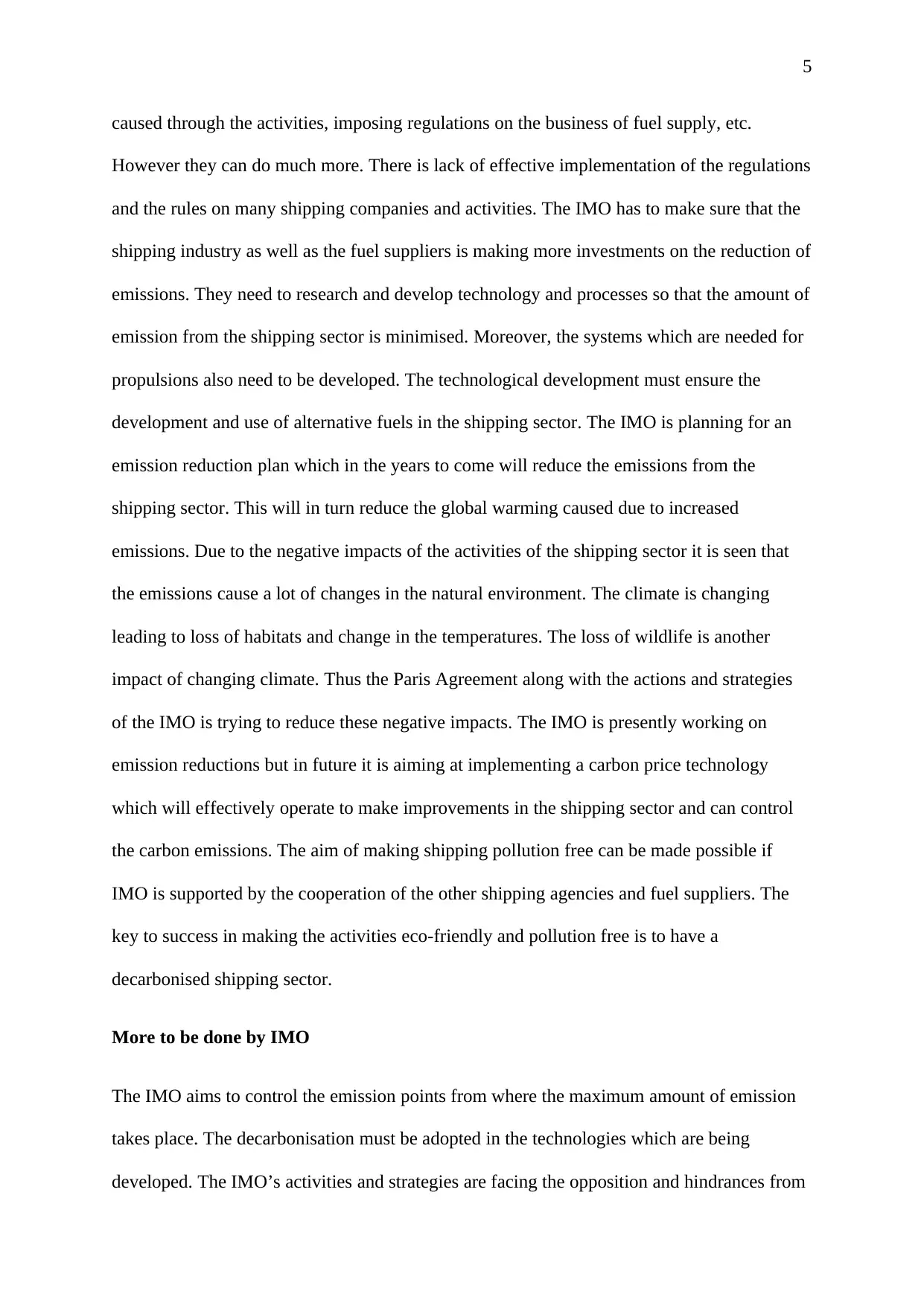
5
caused through the activities, imposing regulations on the business of fuel supply, etc.
However they can do much more. There is lack of effective implementation of the regulations
and the rules on many shipping companies and activities. The IMO has to make sure that the
shipping industry as well as the fuel suppliers is making more investments on the reduction of
emissions. They need to research and develop technology and processes so that the amount of
emission from the shipping sector is minimised. Moreover, the systems which are needed for
propulsions also need to be developed. The technological development must ensure the
development and use of alternative fuels in the shipping sector. The IMO is planning for an
emission reduction plan which in the years to come will reduce the emissions from the
shipping sector. This will in turn reduce the global warming caused due to increased
emissions. Due to the negative impacts of the activities of the shipping sector it is seen that
the emissions cause a lot of changes in the natural environment. The climate is changing
leading to loss of habitats and change in the temperatures. The loss of wildlife is another
impact of changing climate. Thus the Paris Agreement along with the actions and strategies
of the IMO is trying to reduce these negative impacts. The IMO is presently working on
emission reductions but in future it is aiming at implementing a carbon price technology
which will effectively operate to make improvements in the shipping sector and can control
the carbon emissions. The aim of making shipping pollution free can be made possible if
IMO is supported by the cooperation of the other shipping agencies and fuel suppliers. The
key to success in making the activities eco-friendly and pollution free is to have a
decarbonised shipping sector.
More to be done by IMO
The IMO aims to control the emission points from where the maximum amount of emission
takes place. The decarbonisation must be adopted in the technologies which are being
developed. The IMO’s activities and strategies are facing the opposition and hindrances from
caused through the activities, imposing regulations on the business of fuel supply, etc.
However they can do much more. There is lack of effective implementation of the regulations
and the rules on many shipping companies and activities. The IMO has to make sure that the
shipping industry as well as the fuel suppliers is making more investments on the reduction of
emissions. They need to research and develop technology and processes so that the amount of
emission from the shipping sector is minimised. Moreover, the systems which are needed for
propulsions also need to be developed. The technological development must ensure the
development and use of alternative fuels in the shipping sector. The IMO is planning for an
emission reduction plan which in the years to come will reduce the emissions from the
shipping sector. This will in turn reduce the global warming caused due to increased
emissions. Due to the negative impacts of the activities of the shipping sector it is seen that
the emissions cause a lot of changes in the natural environment. The climate is changing
leading to loss of habitats and change in the temperatures. The loss of wildlife is another
impact of changing climate. Thus the Paris Agreement along with the actions and strategies
of the IMO is trying to reduce these negative impacts. The IMO is presently working on
emission reductions but in future it is aiming at implementing a carbon price technology
which will effectively operate to make improvements in the shipping sector and can control
the carbon emissions. The aim of making shipping pollution free can be made possible if
IMO is supported by the cooperation of the other shipping agencies and fuel suppliers. The
key to success in making the activities eco-friendly and pollution free is to have a
decarbonised shipping sector.
More to be done by IMO
The IMO aims to control the emission points from where the maximum amount of emission
takes place. The decarbonisation must be adopted in the technologies which are being
developed. The IMO’s activities and strategies are facing the opposition and hindrances from
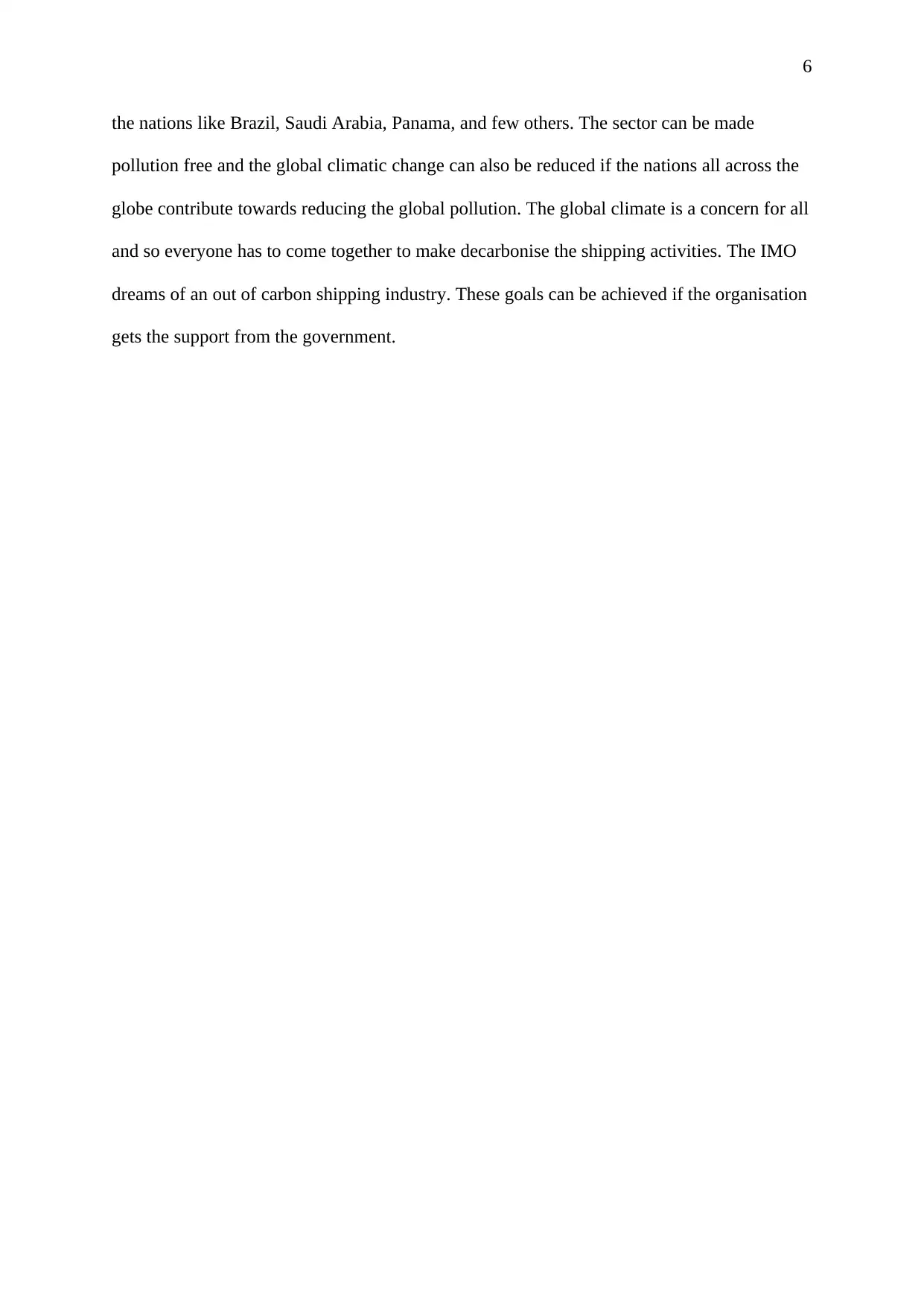
6
the nations like Brazil, Saudi Arabia, Panama, and few others. The sector can be made
pollution free and the global climatic change can also be reduced if the nations all across the
globe contribute towards reducing the global pollution. The global climate is a concern for all
and so everyone has to come together to make decarbonise the shipping activities. The IMO
dreams of an out of carbon shipping industry. These goals can be achieved if the organisation
gets the support from the government.
the nations like Brazil, Saudi Arabia, Panama, and few others. The sector can be made
pollution free and the global climatic change can also be reduced if the nations all across the
globe contribute towards reducing the global pollution. The global climate is a concern for all
and so everyone has to come together to make decarbonise the shipping activities. The IMO
dreams of an out of carbon shipping industry. These goals can be achieved if the organisation
gets the support from the government.
⊘ This is a preview!⊘
Do you want full access?
Subscribe today to unlock all pages.

Trusted by 1+ million students worldwide
1 out of 6
Related Documents
Your All-in-One AI-Powered Toolkit for Academic Success.
+13062052269
info@desklib.com
Available 24*7 on WhatsApp / Email
![[object Object]](/_next/static/media/star-bottom.7253800d.svg)
Unlock your academic potential
Copyright © 2020–2025 A2Z Services. All Rights Reserved. Developed and managed by ZUCOL.





